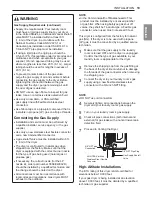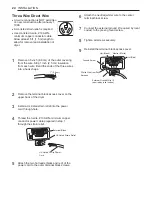
25
INSTALLATION
ENGLISH
Three-Wire Direct Wire
•
A 3-wire connection is NOT permitted
on new construction after January 1,
1996.
•
A UL-listed strain relief is required.
•
Use UL-listed 3-wire, #10 AWG-
minimum copper conductor cable.
Allow at least 5 ft. (1.5 m) length to
allow for removal and installation of
dryer.
1
Remove 3.5-inch (8.9 cm) of the outer covering
from the wire. Strip 1 inch (2.5 cm) insulation
from each wire. Bend the ends of the three wires
into a hook shape.
1" (2.5 cm)
2
Remove the terminal block access cover on the
upper back of the dryer.
3
Install a UL-listed strain relief into the power
cord through-hole.
4
Thread the 3-wire, #10 AWG-minimum copper
conductor power cable prepared in step 1
through the strain relief.
Terminal Block
UL-Listed Strain Relief
UL-Listed 3-Wire Power
Cord
5
Attach the two hot leads (black and red) of the
power cord to the outer terminal block screws.
6
Attach the neutral (white) wire to the center
terminal block screw.
7
Connect the external ground (if required by local
codes) to the green ground screw.
8
Tighten all screws securely.
9
Reinstall the terminal block access cover.
Hot (Black)
Ground Screw
White Wire from Dryer
harness
External Ground Wire (If
required by local codes)
Hot (Red)
Neutral (White)
Special Electrical
Requirements
(For Mobile or Manufactured Homes)
•
Any installation in a manufactured or mobile
home must comply with the Manufactured Home
Construction and Safety Standards Title 24 CFR,
Part 3280 or Standard CAN/ CSA Z240 MH and
local codes and ordinances. If you are uncertain
whether your proposed installation will comply with
these standards, please contact a service and
installation professional for assistance.
•
A 4-wire connection is required for all mobile and
manufactured home installations, as well as all new
construction after January 1, 1996.
•
A gas dryer must be permanently attached to the
floor.
•
The electrical connection for an electric dryer must
be a 4-wire connection. More detailed information
concerning the electrical connection is provided in
the section Connecting Electric Dryers.
•
To reduce the risk of combustion and fire, the dryer
must be vented to the outside.
•
DO NOT vent the dryer under a manufactured home
or mobile home.
•
Electric dryers may be vented to the outside using
the back, left, right, or bottom panel.
•
Gas dryers may be vented to the outside using the
back, left, or bottom panel. Gas dryers may not
be vented to the outside using the right side panel
because of the burner housing.
•
The dryer exhaust duct must be affixed securely to
the manufactured or mobile home structure, and the
exhaust duct must be made of a material that will
resist fire and combustion. It is recommended that
you use a rigid, semi-rigid or flexible metal duct.
•
DO NOT connect the dryer exhaust duct to any
other duct, vent, chimney, or other exhaust duct.
•
Make sure the dryer has adequate access to
outside fresh air to ensure proper operation. The
opening for outside fresh air must be at least
25 sq. in (163 cm²).
•
It is important that the clearance of the duct from
any combustible construction be at least 2-inch
(5 cm), and when venting the dryer to the outdoors,
the dryer should be installed with a clearance of at
least 1 inch (2.5 cm) at the sides and back of the
dryer.
•
Please be aware that venting materials are not
supplied with the dryer. You must obtain the venting
materials necessary for proper installation.
Final Installation Check
Once you have completed the installation of the dryer
and it is in its final location, confirm proper operation
with the following tests and Installation Test (Duct
Check).
Testing Dryer Heating
GAS MODELS
Close the dryer door and press the
POWER
button
to turn the dryer on. Press the
Time Dry
and
START/
PAUSE
buttons to start the test. When the dryer
starts, the igniter should ignite the main burner.
NOTE
•
If all air is not purged from the gas line, the gas
igniter may turn off before the main burner ignites. If
this happens, the igniter will reattempt gas ignition
after approximately two minutes.
ELECTRIC MODELS
Close the dryer door and press the
POWER
button
to turn the dryer on. Press the
Time Dry
and
START/
PAUSE
buttons to start the test. The exhaust air
should be warm after the dryer has been operating
for 3 minutes.
Checking Airflow
Effective dryer operation requires proper airflow.
The adequacy of the airflow can be measured by
evaluating the static pressure. Static pressure in the
exhaust duct can be measured with a manometer,
placed on the exhaust duct approximately 2 ft.
(60.9 cm) from the dryer. Static pressure in the
exhaust duct should not exceed 0.6 inch (1.5 cm).
The dryer should be checked while the dryer is
running with no load.
Checking Levelness
Once the dryer is in its final location, recheck the
dryer to be sure it is level. Make sure it is level front
to back and side to side, and that all four leveling feet
are in firm contact with the floor.
Содержание Dle1501 series
Страница 46: ...46 MEMO ...
















































